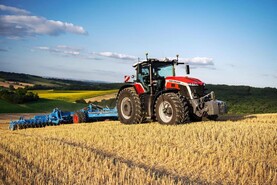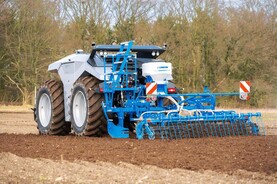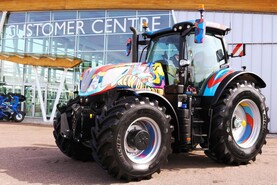New John Deere 6195M
John Deere product specialists have described this new addition to the M range as being from the same stable as the old and sought-after John Deere 7810 with the power of 8000 series.
According to John Deere, this tractor will be a great all-rounder for many contractors and farmers who do not require the higher specification of the R series.
The new 6M series tractors are now available with a mechanical cab suspension, which takes the bumps out. The company also claims that the smoother operation, as well as reduced stress and vibration levels, allow a 10% higher operating speed, even on rough terrain.
The same TLS+ triple-link front axle suspension is fitted on the M series. The 6M series tractors can be equipped with three rear SCVs and a new PowerBeyond function, or four standard selective control valves (SCVs) with three mid-stack SCVs.
The PowerBeyond hydraulic system is used as a pressure or flow source for additional functions equipped with independent flow control valves.
An electrical loader-ready joystick is also available for use with John Deere’s new R series front loaders. The 6R and 6M series tractors are specifically designed to accommodate these loaders, which feature new mounting frames and hood guards and are easy to attach and operate.
McCormick X7s
Hoping to appeal to users migrating from MTX models, as well as offering more spec choice to potential customers, McCormick has developed an efficient specification version of its X7 range.
Available on its four-cylinder X7 models and a newly introduced 150hp, six-cylinder X7650, the tractors are effectively a lower-spec version of its current X7 machines.
Most notable differences can be found in the cab, which migrates the armrest controls to a console mounted on the fender. Mechanical spool controls are also included.
Claas extends the Axion
At Agritechnica, Claas unveiled its new Axion 870 to extend the model lineup. Claas is following the trends from other manufacturers by delivering tractors with improved power to weight ratios. This makes them more appealing to a variety of tasks, especially for contractors and larger farmers.
Karol Duigenan from Claas Ireland explained that if customers wanted a more powerful tractor than what was available in the 800 series, the only option was the bigger 900 tractor, which may not have suited them. According to Karol, this tractor has the power and size to perform high horsepower operations and the ability to be used for all other tasks on the farm.
The tractor delivers this power from a 6.7-litre Fiat PowerTrain (FPT) engine using the Claas power management system. This delivers an extra 31hp when compared with the Axion 850 model, which has the same dimensions and weights. Claas claims that this makes the tractor more suitable for larger field and roadwork applications.
At speeds above 14km/h and whenever power take-off work is being performed, the system automatically provides additional torque and an extra 15hp of power through the electronic engine control system. The engine is Tier IV compliant.
The Axion 870 tractor is equipped as standard with the continuously variable Cmatic transmission.
Claas believes that this type of transmission is best suited to this size of tractor. It allows for high speed or low speed with high torque demands on a variety of tasks including using butterfly mower combinations. The Claas Hexashift transmission is not available on this top-of-the-range model.
Controlling all major tractor functions in the cab is the Cebis control lever. In addition, the Cebis terminal allows the setup of all tractor functions, including a headland management control.
The 870 can optionally be equipped ex-factory with the manufacturer’s GPS pilot steering system, with its S10 or S7 touchscreen terminal.
McCormick X8 series
Representing the largest tractors it has ever produced, McCormick launched its new, three-model X8 series.
Comprising the X8 660, X8 670 and X8 680, the series ranges from 264hp to 310hp (maximum rated). Grunt is supplied by FPT, with engines built to McCormick’s specifications and rebadged as Beta Power.
To manage torque curves and engine response better, the engines use a variable geometry turbo. Carrying no structural stresses, engines are mounted in a half-chassis design derived from the old ZTX series.
Bolted to the back of the chassis is a continuously variable transmission from ZF. Using a combination of a hydrostatic motor and four mechanical ranges, it offers a seamless transition of speeds from 0 to 40km/h (economy version) or 0 to 50km/h.
At the rear, it is capable of lifting 12,000kg and features a three-speed PTO. Hydraulic performance is 157 litres/minute as standard or 212 litres/minute optional.
To get the power to the ground, 900/60 R42 rear tyres can be fitted. For the operator, it shares the same cab as developed for the X7, along with the same control logic.
Landini 7 Series V-Shift
For the first time, Landini launched a tractor series with a continuously variable transmission (CVT) at Agritechnica. Called V-Shift, it is available on five of its 7 series models; three four-cylinder machines and two six-cylinder machines.
The transmission comes from ZF and is operated using the same controls as Landini’s powershift tractors. The key difference is that the grip now moves backwards and forward to control speed. Four modes of driving can be selected: manual, auto, PTO or cruise.
As the name suggests, in manual mode, the driver selects the revs and the CVT ratio. In auto, you tell the tractor what speed to go and it will automatically select the revs and ratios with the best economy in mind.
PTO mode allows the driver to decide what revs they require using the hand throttle. And cruise mode allows the driver to select target speeds, which can be adjustable.
In addition, V-Shift machines come as standard with Landini’s new 12in touchscreen terminal, offering increased tractor functionality, as well as implementing IsoBus control.
New Holland T7HD
Making its debut at the show was New Holland’s T7HD range, extending its current range of T7 tractors with two new models up to 315hp.
Designed in response to customer feedback, the manufacturer says the tractors have been developed from the outset to be versatile machines, able to carry out high-power PTO and transport duties, but also with the ability to be ballasted up for draft applications.
In doing so, the new models address a gap in the firm’s range, which the heavier, more load-lugging type tractors of the T8 range could not fulfil.
More than just an engine tweak, the firm says the T7HDs are completely new tractors, with many specially designed components.
In particular, the engine incorporates a load-bearing sump, which carries much of the tractor’s stresses and strains, rather than transmitting them through the engine block. This also means it does not have to use a chassis, allowing for a greater steering lock and a tighter turning circle. A variable geometry turbo is also used to keep up engine response, and Stage IV emissions levels are met using AdBlue only.
At the rear is an updated version of the firm’s AutoCommand continuously variable transmission, standard on both models. Also standard is a four-speed PTO. Tyres up to 2.15m in diameter can be fitted, and a tyre pressure-monitoring system allows you to keep tabs on tyres. For comfort, the tractors use a front suspension unit derived from the T8 range.
New Case Optum is Machine of the year
The new Case IH Optum range fills the gap between the Puma and Magnum models, with two models at 270hp and 300hp. Some of the key features of the new tractor include a standard four-speed rear PTO and two-speed front PTO, which is unique in this class of tractor.
Case IH product manager Dan Stuart said: “Following the first feedback received from dealers, customers and visitors at Agritechnica, the distinction as machine of the year 2016 now gives evidence that we indeed landed a major coup with the Optum CVX.”
Both models are available only with continuously variable speed CVX transmissions. Powering the Optum range is a fully reworked Tier IV final, 6.7-litre NEF engine from FPT.
There is no boost facility on Optum models. Rated horsepower of 270hp and 300hp are achieved on both models at a rated speed of 2,100rpm. Maximum power of 313hp is achieved at 1,800rpm on the larger of the two.
Quite a bit of work has been done on the tuning side to meet stringent Tier IV final emission standards and get the extra power out of the engine.
This was done without adding exhaust gas recirculation (EGR) or a diesel particulate filter (DPF).
Pumping more air into the engine is a single electronically controlled variable geometry turbo (VGT).
Lower-powered Pumas use a standard waste-gate turbo. The turbo incorporates some clever features including an exhaust flap which closes to get the engine up to running temperature quicker.
As an option, this can be used as an exhaust brake, operated by a second accelerator pedal on the left of the foot pedal.
Just like the latest New Holland T7 tractors, the engine receives a structural sump and the new design eliminates the need for side-rail supports.
The Optum’s drivetrain is based on that of the Puma, but beefed up to handle the extra power.
Internally, gear ratios are also different from the Puma, while final drives feature a double epicyclic unit. There are four mechanical ranges within the CVX transmission to provide maximum efficiency, according to the manufacturer.
Deutz-Fahr methane- powered tractor
In conjunction with the University of Rostock, Deutz-Fahr showed a prototype version of a methane-powered tractor.
Based on a 5120 C model, the tractor uses an adapted Deutz Ag engine. Producing near zero emissions when using bio-methane, the tractor does not need any cleanup systems, such as exhaust gas recirculation or selective catalytic reduction, dramatically reducing the amount of emission control systems on the tractor.
Methane storage tanks are located under the cab and around the cab frame. Power and torque levels are said to be similar to its diesel counterpart.
There are no plans for full commercial production yet, but the tractor is likely to appeal to users running their own bio-gas plants (anaerobic digesters) for a source of low-cost fuel.






 This is a subscriber-only article
This is a subscriber-only article















SHARING OPTIONS: